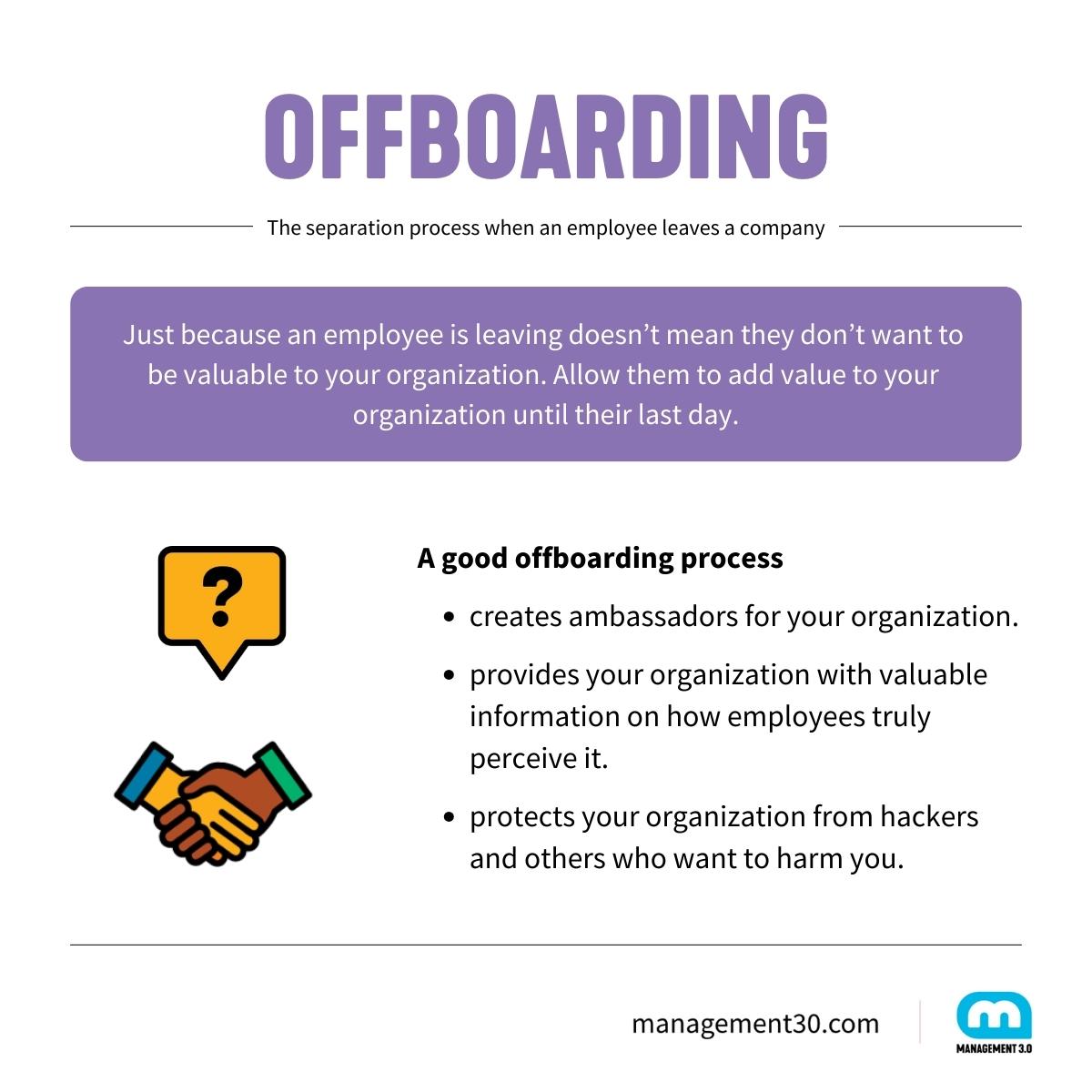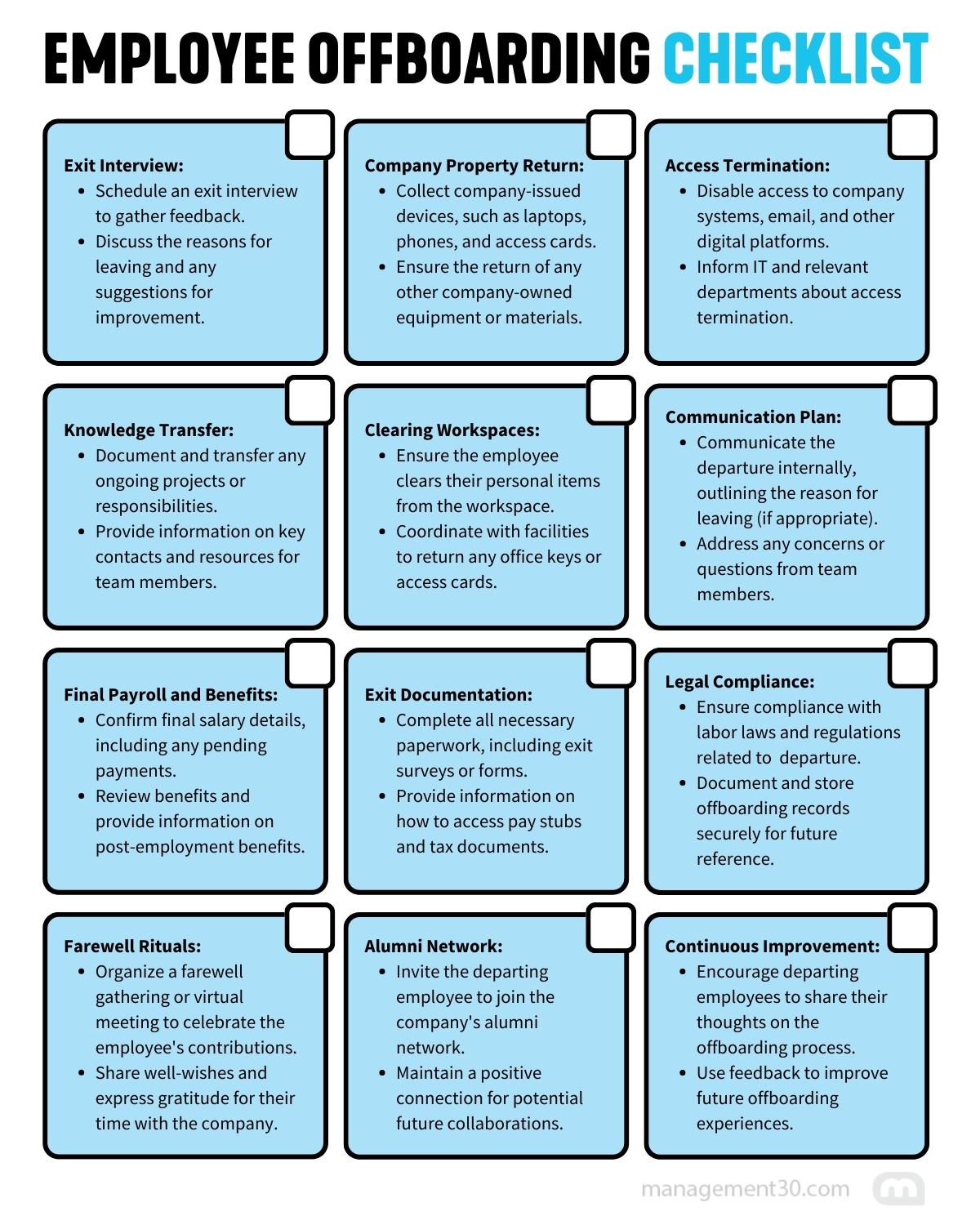An article by Management 3.0 Facilitator and content creator, Ralph van Roosmalen. Ralph specializes in management and leadership coaching, agile coaching, and organizational development support. In 2017, he published the book “Doing It – Management 3.0 Experiences,” followed by the book “Art of Teams.”
I have conducted a lot of recruitment. Our department grew rapidly in the Netherlands, Romania, and the US. Once we said yes, we initiated the onboarding process, creating all the accounts and maintaining contact with the new hire. We did not keep track of all the hours, but we spent close to 40 hours on hiring and onboarding new team members. Guess how many hours we spent when people left?
If time permitted, we conducted an exit interview and closed their Windows account; that was basically it.
What a mistake, looking back.
The Employee Offboarding Process
Offboarding is a crucial part of the employee experience and is vital for your organization.
- A good offboarding process will create ambassadors for your organization.
- It will provide your organization with valuable information on how employees truly perceive it.
- It protects your organization from hackers and others who want to harm you.
A Proper Employee Offboarding Process Limits “Hackers”
“Relying on the good faith of ex-employees turns out to be a bad idea. In OneLogin’s survey, 20 percent of the respondents reported that failure to deprovision employees from corporate applications contributed to a data breach at their organization.”
We live in the digital age, and an organization’s data is often crucial. It can be a unique intellectual property that makes a difference in the market, or the data is very sensitive, and a data breach would destroy the organization’s reputation.
When people have switched many teams or roles in an organization, they often build up access entries. After many years, they have access to every system in the organization because there is no procedure to revoke access when people change roles or leave the organization. This is a real danger for your IT security. You need to track which systems people can access and revoke when needed. You can’t do this manually; you must track it in an IT system. Ensuring people are correctly offboarded when they leave or switch roles is an important step in an offboarding process. Can you, at this moment, create an overview of all system access you or a colleague has?
A Proper Employee Offboarding Process Creates Ambassadors
In the module “Hire Great People,” we mention that when you reject people during the recruitment process, you need to make sure that they become ambassadors for your organization. Always treat people with respect and give them a great experience during recruitment.
This is also the case for people leaving your organization. If someone has decided to leave your organization, you should not feel angry or negative towards them. Your goal should be to give them a pleasant experience while leaving your organization. Spend as much time guiding them to their new job as when you hired them. For example, ensure they have time to transfer their work to other team members.
Just because they are leaving doesn’t mean they don’t want to be valuable to your organization. Allow them to add value to your organization until their last day.

Also, it is a small world, and you never know when you will meet again. Try to stay in touch with them after they have left. I know organizations where they organize a reunion once a year where people who left can visit the organization and have drinks with old colleagues. When they become ambassadors, they may refer other people to your organization, and they may join your organization again in the future.

Exit Interview
Let’s take some more time to talk about the exit interview.
What is an Exit Interview?
An exit interview is a survey conducted with an individual who is separating from an organization or relationship (source: Wikipedia).
Questions to Ask During an Exit Interview
Traditionally, an exit interview focuses on why people decided to leave.
What should have been done differently to prevent them from leaving the organization? Were they happy with their salary? Did they feel engaged? Did they feel supported by their leader?
These are interesting questions, but should we not ask them before people decide to leave?
The traditional exit interview focuses on the past and, when we are lucky, gives us insights into things we can improve in the future.
However, it’s like when the Titanic is sinking; let’s discuss what happened and how we can do better next time we encounter an iceberg. It is too late.
In a Management 3.0 organization, we want to create a system where people always feel safe sharing their feedback with each other and leaders: good things and bad things. One of the principles of Management 3.0 is to improve the system. The feedback of your team members is essential to collect ideas to improve. Some people will say the exit interview is important as this is when people are really honest. An option to improve the system. However, it should be done continuously, not when someone leaves the organization. When you hear feedback during the exit interview that people did not dare to share earlier, all alarm bells should be ringing!
An Addition to the Traditional Exit Interview: The Stay Interview
A Stay Interview is a proactive approach used by organizations to engage with current employees and understand their motivations, concerns, and overall job satisfaction. Unlike exit interviews, which are conducted when an employee is leaving the company, stay interviews are performed while the employee is still actively working with the organization.
The primary goal of a Stay Interview is to identify factors that contribute to an employee’s job satisfaction and commitment to the organization. It allows employers to gain insights into what is working well, what might need improvement, and what factors contribute to an employee’s decision to stay with the company.
You could start an exit interview by sharing statements about how safe people feel in your organization. Example statements are:
- I feel safe asking for help when I need it.
- I feel like my mistakes are treated as learning opportunities rather than personal failures.
- I feel like my team is a place where I can learn and grow without fear of judgment.
This will start a valuable discussion about psychological safety in your organization. Do people agree or disagree with the statements? If they disagree, the next question can be about what is needed to make the organization safe to share feedback. An exit interview focusing on psychological safety will give you tips and ideas to improve the organization. It will help others share their feedback on their feelings and help you prevent people from leaving the organization.
A job should be something you do for that magical period of time when you are the best person for that job and that job is the best position for you. Once you stop learning or stop excelling, that’s the moment for you to pass that spot onto someone who is better fitted for it and to move on to a better role for you.
Reed Hastings, Erin Meyer: No Rules Rules. Netflix and the Culture of Reinvention
When your organization is safe, and people share with their leaders that they are looking for a new job, you should be happy. The time when people join an organization for decades is no longer. Organizations are constantly in motion, changing and improving, and during this continuous journey, people join organizations. They use their skill and experience to help the organization, and in return, they grow their skills and experiences. It is a win-win. When people leave these organizations, you want to learn why they enjoyed their time at your organization. What is it that you should do more?
Example questions are:
- What made you feel happy at work?
- What is the biggest challenge you enjoyed?
- What did the people around you do to make you feel motivated?
- What should this organization never stop doing?
These questions will give you insight into what makes your organization a great workplace. Remember, your employee already shared with you that they are leaving. You don’t need to focus on the reason, as they already shared this with you.

Employee Offboarding Experience
People will leave your organization. That is a fact. Your goal should be to make the time together valuable for the employee and the organization, creating a win-win situation for both. We often spend a lot of time recruiting and onboarding people. We should also ensure we spend a significant amount of time offboarding people. Offboarding people is important to ensure we revoke access to IT systems, create ambassadors, and learn about our organization. Revoking access is important to stay safe in the digital world. We want people who leave our organization to become ambassadors for our organization. When we hear feedback during the exit interview that we have never heard before, it is clear that the organization is not perceived as safe by employees. In that case, exit interviews should focus on learning what is needed to become a safe organization. When the organization is perceived safe, the exit interview should focus on learning what made the organization a great place to work.


